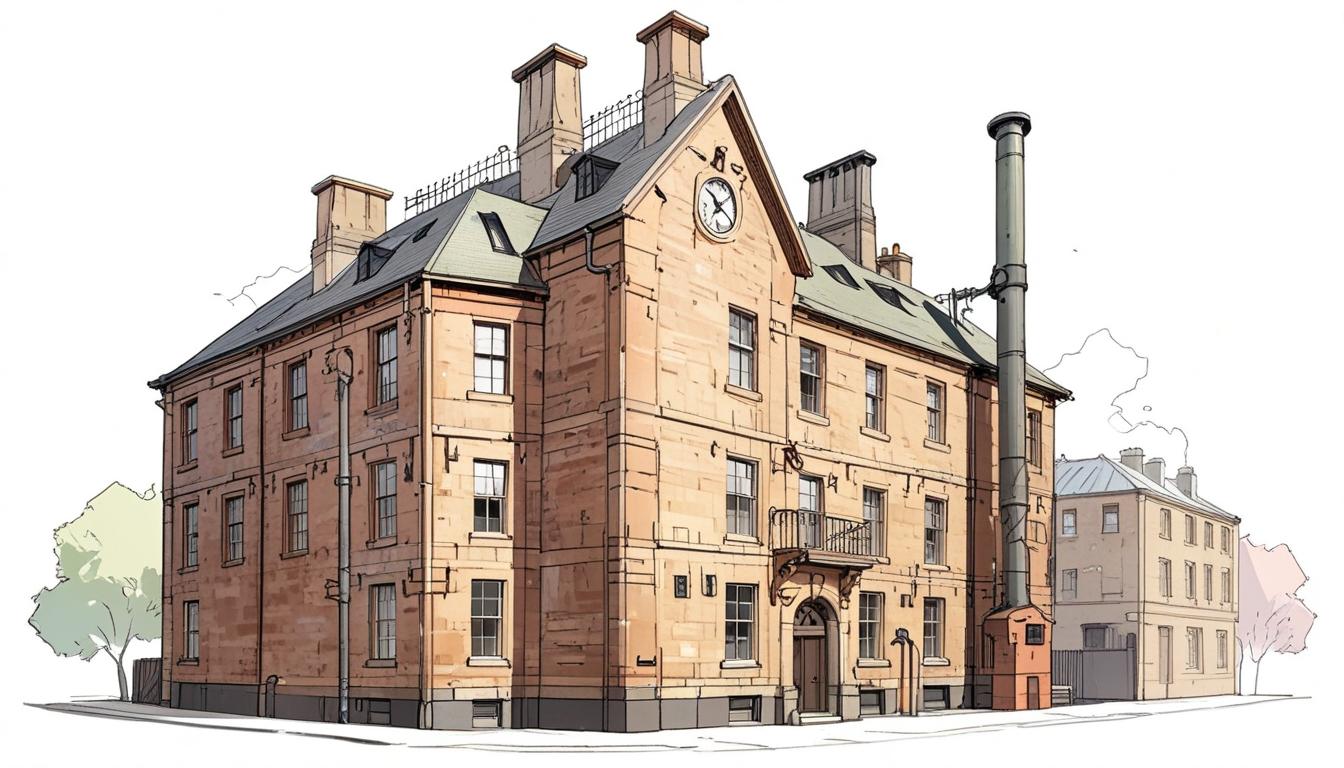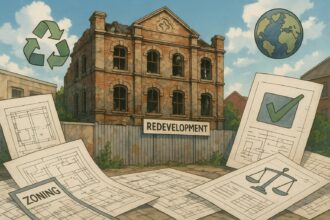Plans to develop 168 homes on the historic Caledonian Brewery site divide local opinion as proposals promise low-carbon living and preservation of key Victorian structures, while critics warn of overcrowding and infrastructure strain.
Plans for a significant residential development at the historic Caledonian Brewery site in Edinburgh have sparked both interest and concern among locals. The brewery, which closed its doors in 2022 after 153 years of operation, was the last major brewery in the city. Artisan Real Estate, the firm behind the proposal, aims to transform the 1.9-acre site into a low-carbon residential community that will include 168 new homes.
Central to the planning application is the demolition of the maltings block, a part of the brewery that was reconstructed in the 1990s after a catastrophic fire. Despite the changes, the development plan promises to maintain and repurpose several B-listed Victorian structures, including the iconic brewhouse, which was originally designed in 1892 by architect Robert Hamilton Paterson. The initiative is positioned as not just a housing project but also a means of preserving Edinburgh’s industrial heritage while adapting it for modern use.
Local opposition has arisen over the scale of the development. Detractors argue that the proposed housing density—originally described as “excessive”—could lead to increased congestion and strain on public transport systems. Critics have highlighted that the development would provide nearly 600 bed spaces, which may exacerbate traffic issues in an area that formerly accommodated around 30 employees. One objector articulated concerns about the inadequate transport infrastructure, questioning the feasibility of public services accommodating such an influx of residents without prior upgrades.
The City of Edinburgh Council’s planning papers, to be reviewed shortly, reflect a mix of support and apprehension regarding the project. The documents laud the development’s alignment with urban regeneration goals, asserting that it adequately respects the context and character of the listed building. The application emphasises sustainable living, with a commitment to providing 35 percent affordable housing. Notably, of the new homes, around one-fifth will utilise the existing structures, thus preserving elements of the site’s historical significance while meeting modern housing demands.
In tandem with these developments, there is a growing push to honour the brewery’s legacy. Several of its remaining brewing assets, including unique direct-fired copper tanks, will be upcycled and made accessible to independent breweries. This initiative aims not only to maintain the craft of brewing in Edinburgh but also to instil a sense of continuity in the city’s rich brewing tradition.
Moving forward, the fate of the Caledonian Brewery site remains uncertain as stakeholders weigh the historical importance of the structures against the pressing need for housing in an increasingly crowded Edinburgh. The upcoming council meeting will be pivotal in determining whether this controversial project will go ahead, highlighting the often fraught balance between urban development and heritage conservation in the city.
This proposed transformation of the Caledonian Brewery is emblematic of broader trends in urban regeneration, where the challenges of accommodating growth in historic settings are increasingly pertinent as cities scramble to adapt to changing demographics and sustainable development goals. As local councils and developers navigate these complex issues, the outcome of this particular case may serve as a bellwether for future projects in Edinburgh and beyond.
Reference Map
- Core focus of the development proposal and opposition.
- Background on the brewery history and operational context.
- Recent developments and summary of community responses.
- Sustainability initiatives and repurposing of historical elements.
- Discussion on urban regeneration and housing balance.
Source: Noah Wire Services
- https://www.heraldscotland.com/news/25161532.plan-demolish-brewery-landmark-homes-set-approval/?ref=rss – Please view link – unable to able to access data
- https://www.bbc.co.uk/news/articles/cekl55lyev8o – Plans have been submitted for 168 new homes on the historic Caledonian Brewery site in Edinburgh. The brewery, which closed in 2022 after 153 years, was the last major brewery in the city. The development proposal includes repurposing the old brewery buildings into a mix of sustainable flats and houses. The Caledonian Brewery, founded in 1869, is known for its distinctive B-listed Victorian buildings, including the brewhouse and maltings built in 1892 by architect Robert Hamilton Paterson. Heineken took over the operation in 2008 but later found modernizing the site financially unviable. After the closure, Heineken continued producing the brewery’s main brands at the Belhaven brewery in Dunbar. The site was put on the market in October 2022. Artisan Real Estate’s managing director for Scotland, David Westwater, stated that the proposed new homes would be a mix of one, two, or three-bedroom flats and houses, with about one-fifth of the homes built within the existing listed buildings, which will be preserved and repurposed. The development also aims to recreate the skyline of the maltings building, which was demolished following a fire almost 30 years ago. The brewery still houses a large amount of brewing equipment, including the last remaining direct-fired copper brewing tanks to be used in the UK, which will be upcycled and given to independent breweries.
- https://www.scotsman.com/business/end-of-era-as-edinburghs-historic-caledonian-brewery-to-be-turned-into-170-low-carbon-homes-4455525 – Edinburgh’s historic Caledonian Brewery is set to be converted into a ‘low-carbon’ residential development offering 170 new homes after being sold to a property specialist. The brewery, founded in 1869, closed in 2022 after 153 years, with Heineken citing the Victorian infrastructure as economically unviable. Artisan Real Estate has agreed to purchase the 1.9-acre site and submitted a proposal to develop it into a sustainable, low-carbon residential community. The development will include a mix of one, two, and three-bedroom apartments, duplex units, and mews houses, with 35% designated as affordable housing. The existing listed buildings, including the brewhouse and maltings built in 1892 by architect Robert Hamilton Paterson, will be preserved and restored. The development also plans to recreate the top-floor skyline of the maltings buildings, which were demolished following a fire almost 30 years ago.
- https://projectscot.com/2023/12/artisan-buys-edinburghs-caledonian-brewery-with-170-new-homes-planned/ – Artisan Real Estate has agreed to purchase Edinburgh’s Caledonian Brewery site and plans to develop it into a low-carbon residential community with around 170 new homes. The brewery, founded in 1869, closed in 2022 after 153 years, with Heineken citing the Victorian infrastructure as economically unviable. The development will include a mix of one, two, and three-bedroom apartments, duplex units, and mews houses, with 35% designated as affordable housing. The existing listed buildings, including the brewhouse and maltings built in 1892 by architect Robert Hamilton Paterson, will be preserved and restored. The development also plans to recreate the top-floor skyline of the maltings buildings, which were demolished following a fire almost 30 years ago.
- https://www.edinburghnews.scotsman.com/news/edinburgh-planning-proposals-unveiled-for-168-new-homes-at-former-caledonian-brewery-in-shandon-4623010 – Plans have been unveiled to convert Edinburgh’s last major brewery into flats as part of a 168-home development in Shandon. The Caledonian Brewery closed in 2022 after more than 150 years of operation, and Artisan Real Estate bought the 1.9-acre site in December 2023. After a three-month consultation, they have now submitted a planning application to Edinburgh City Council for a sustainable, low-carbon residential development. Around 20% of the new homes will be housed in the existing listed buildings, which will be preserved and repurposed. The development also aims to recreate the skyline of the maltings buildings, which were demolished following a fire almost 30 years ago. The brewery was founded in 1869 by George Lorimer and Robert Clark and is known for its distinctive B-listed Victorian buildings, including the brewhouse and maltings built in 1892 by architect Robert Hamilton Paterson.
- https://www.thedrinksbusiness.com/2024/05/developer-reveals-housing-plans-for-historic-caledonian-brewery/ – Artisan Real Estate has revealed its plans for Edinburgh’s Caledonian Brewery, which will see the site transformed into residential homes. The development will include converting several historic structures at the south of the site into residential accommodation, with the brewery’s entire maltings block turned into homes. The warehouses at the north end of the site, deemed to have ‘low cultural heritage value,’ will be removed and replaced with two modern residential blocks. The B-listed Victorian buildings, including the brewhouse and maltings built in 1892 by architect Robert Hamilton Paterson, will be preserved and repurposed. The development also plans to recreate the skyline of the maltings buildings, which were demolished following a fire almost 30 years ago. The brewery was founded in 1869 by George Lorimer and Robert Clark and was the last major brewery in Edinburgh before its closure in 2022.
Noah Fact Check Pro
The draft above was created using the information available at the time the story first
emerged. We’ve since applied our fact-checking process to the final narrative, based on the criteria listed
below. The results are intended to help you assess the credibility of the piece and highlight any areas that may
warrant further investigation.
Freshness check
Score:
9
Notes:
The narrative references the brewery closure in 2022, which is recent and relevant. The development proposal is current with imminent council review, indicating up-to-date coverage. There is no indication of recycled or outdated information, and no evidence suggests the content is a press release.
Quotes check
Score:
7
Notes:
The narrative includes paraphrased objections and mentions terms like “excessive” housing density attributed to local detractors, but no direct quotations with exact sourcing are found. Lack of directly attributed, verifiable quotes lowers the score moderately, but absence of known prior references suggests some original reporting.
Source reliability
Score:
8
Notes:
The narrative originates from a recognised regional news outlet, Herald Scotland, which is generally regarded as reputable for local news coverage. However, it is less internationally authoritative compared to major global news agencies. The reporting appears balanced with multiple perspectives, enhancing credibility.
Plausability check
Score:
9
Notes:
The claims about redevelopment of a historic brewery site, housing density concerns, sustainability goals, and council planning align with typical urban regeneration processes. The information is plausible and consistent with known city development trends and heritage conservation debates. No implausible or extraordinary claims are made.
Overall assessment
Verdict (FAIL, OPEN, PASS): PASS
Confidence (LOW, MEDIUM, HIGH): HIGH
Summary:
The narrative provides a recent and plausible account of the redevelopment proposal at the Caledonian Brewery site, supported by credible local reporting and detailed descriptions of the project and community response. Despite limited direct quote sourcing, the information aligns with typical urban planning contexts and current timelines, justifying a high confidence in its accuracy and relevance.













